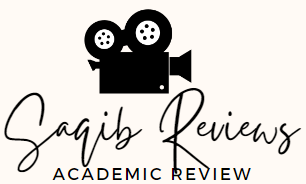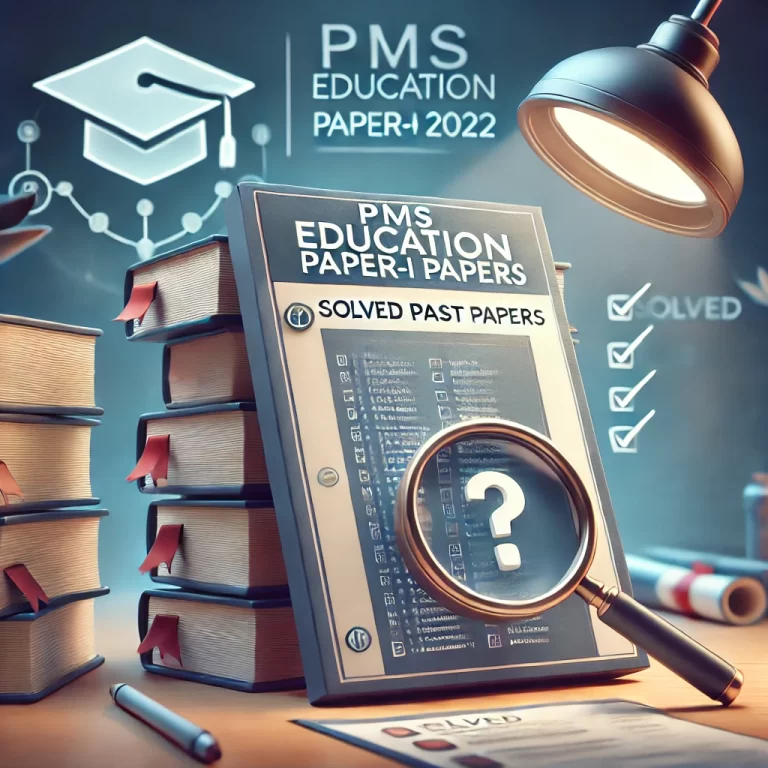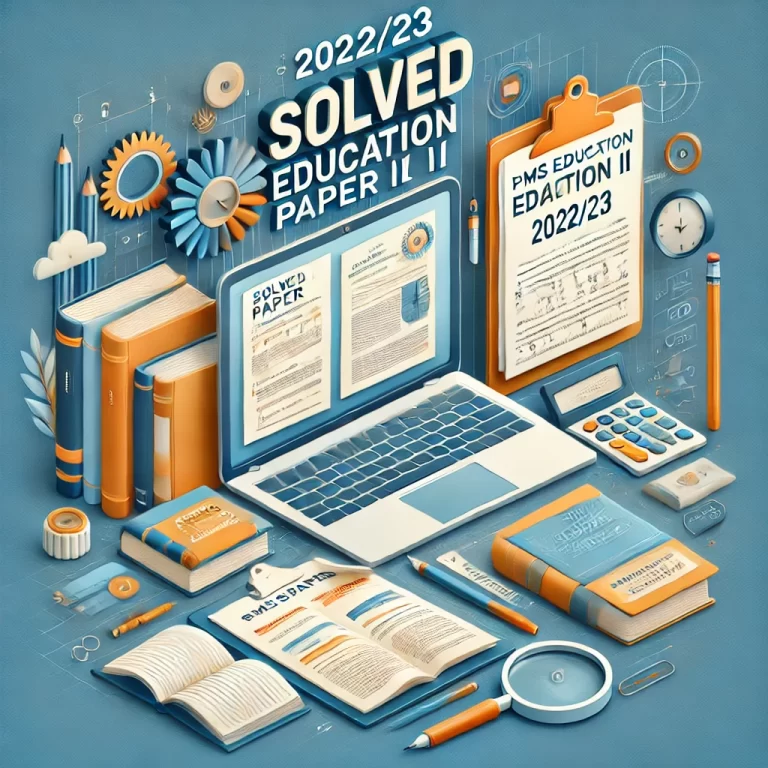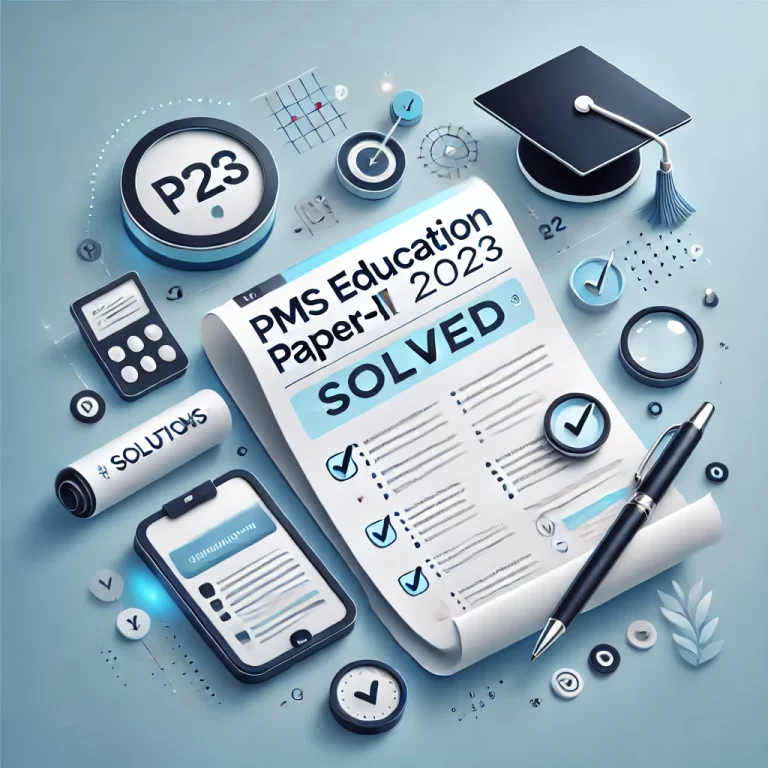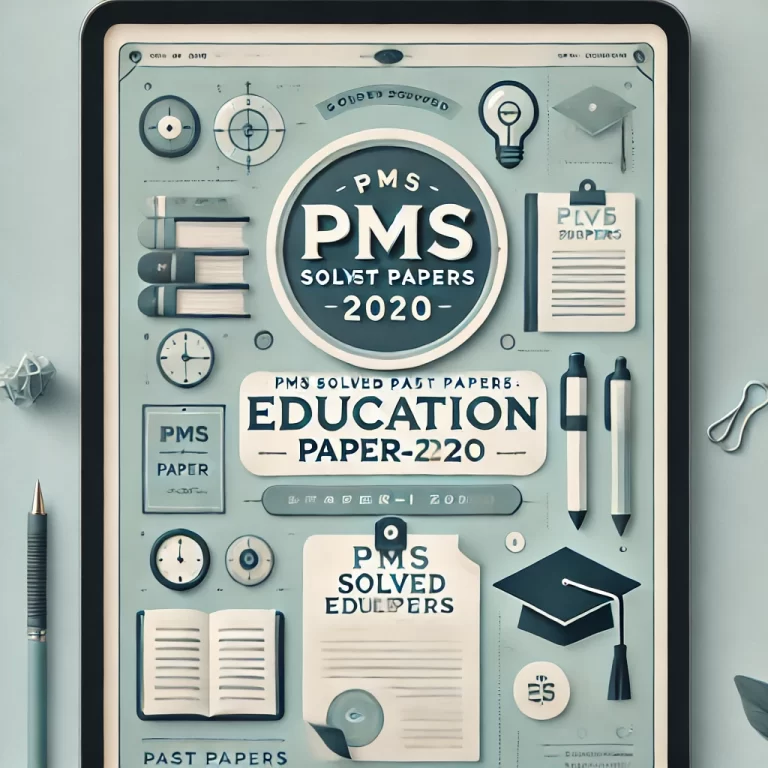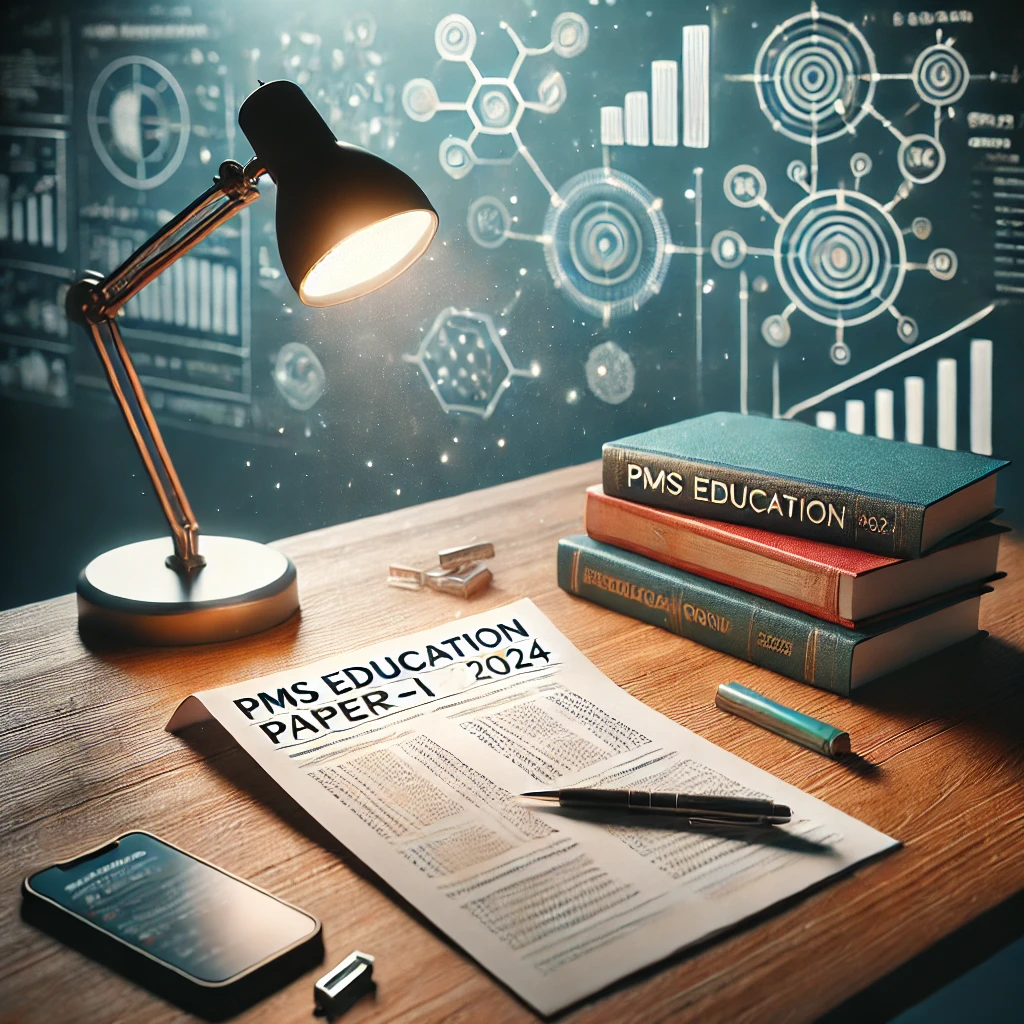
QUESTION NO. 01: National Education Commission 1959 Report: A Critical Analysis
Solved Answer for PMS Education Paper-I (2024) | Expert Insights & Historical Context
Historical Background of the 1959 Commission
The National Education Commission 1959, chaired by Justice S.M. Sharif, was Pakistan’s first comprehensive attempt to reform education post-independence. Established under President Ayub Khan’s military regime, it aimed to:
- Address literacy rates below 20%
- Modernize colonial-era curriculum
- Align education with national development goals
Why It’s Called a “Good Document”
UNESCO praised it as “a visionary blueprint for developing nations”. Key strengths include:
- Holistic focus on primary, technical, and higher education
- Integration of Islamic values with modern science
- Gender equity proposals for rural areas
Key Recommendations & Implementation
1. Universal Primary Education
The commission mandated free compulsory education up to Class 5:
- Proposed 10,000 new primary schools by 1965
- Teacher-student ratio of 1:30
- Urdu as medium of instruction to unify linguistically diverse regions
Impact (1960-1965):
- Primary enrollment increased by 37%
- Female enrollment rose from 11% to 18%
2. Technical & Vocational Training
To combat unemployment and skill gaps:
- Established 12 polytechnic institutes
- Introduced apprenticeship programs with industries
- Allocated 20% of education budget to technical education
3. Teacher Training Reforms
A 5-tier system was proposed:
- Primary Teacher Training Centers (PTTCs)
- Secondary Teacher Training Colleges (STTCs)
- University Departments of Education
Critical Analysis: Strengths vs. Shortcomings
Success Stories
- Punjab Literacy Program (1962): Achieved 45% literacy in pilot districts
- Quaid-e-Azam University: Established using commission’s higher education framework
Implementation Challenges
- Funding Gaps: Only 2.8% of GDP allocated vs. recommended 4%
- Urban-Rural Divide: 70% new schools built in cities
- Language Politics: Resistance to Urdu in East Pakistan (Bangladesh)
— Dr. Pervez Hoodbhoy, Education Reforms in Pakistan (2019)
Modern Relevance & Lessons for 2024
The commission’s ideas still influence Pakistan’s education policies:
Current Applications
- Single National Curriculum (SNC): Echoes 1959’s standardization goals
- HEC Scholarship Programs: Follows the “merit-based funding” model
Recommendations for Today
- Increase education budget to 5% of GDP (as per UNESCO)
- Revive technical education focus to combat youth unemployment (30% rate)
- Digitize teacher training using the commission’s tiered framework
SEO-Optimized FAQ
Q: How does the 1959 report relate to PMS 2024 syllabus?
A: It’s foundational for understanding Pakistan’s education policy evolution (tested in 2018-2023 PMS papers).
Q: Where can I compare the 1959 and 2024 education policies?
A: Read our analysis of PMS Education Paper-II Solutions.
Question NO.02: Why Teachers Must Understand Philosophical Foundations of Education
PMS Education Paper-I Solved Answer | Pakistan-Centric Analysis & Practical Applications
Introduction: Philosophy as a Teacher’s Compass
Philosophy of education is the “why” behind the “what” and “how” of teaching. In Pakistan’s diverse classrooms—where students range from privileged urban elites to rural learners in Sindh’s flood-affected areas—it equips teachers to:
- Design culturally relevant lessons
- Navigate ethical dilemmas (e.g., gender biases)
- Align teaching with national educational goals like the Single National Curriculum (SNC)
5 Reasons Teachers Need Philosophical Knowledge
1. Curriculum Interpretation & Adaptation
Example: A Karachi teacher using progressivism (Dewey) to turn textbook content into project-based learning:
- Students analyze Karachi’s water crisis via science + sociology
- Aligns with SNC’s “critical thinking” objectives
2. Ethical Decision-Making
Scenario: A Khyber Pakhtunkhwa teacher faces pressure to skip “secular” topics.
- Essentialism (Bagley): Prioritize national curriculum
- Social Reconstructionism (Freire): Address community needs
3. Classroom Management Strategies
Philosophical Roots:
- Perennialism (Hutchins): Discipline via classic literature analysis
- Existentialism (Sartre): Student-led rules in Balochistan’s nomadic schools
Impact Data (2023):
- Schools using philosophy-aligned methods: 34% fewer disciplinary issues
- Student engagement up by 41% in Punjab’s pilot programs
4. Bridging Theory & Practice
Case Study: Lahore’s Beaconhouse School System uses constructivism (Piaget):
- Physics concepts taught via bridge-building competitions
- Result: 28% higher STEM retention rates
5. Addressing Societal Needs
Pakistan’s Article 25-A (free education) requires teachers to balance:
- Islamic philosophy (Iqbal’s self-realization)
- Global citizenship (SDG-4)
Philosophy in Pakistan’s Teacher Training
Current Curriculum Gaps
- Only 12% of B.Ed. programs include philosophy practicums
- Reliance on rote learning about philosophers, not application
Success Stories
- AIOU’s Workshop Model: Teachers role-play scenarios using different philosophies
- Punjab’s Lesson Plan Hub: 500+ philosophy-based templates
— Dr. A.H. Nayyar, Reforming Pakistan’s Classrooms (2020)
Challenges in Pakistani Context
- Resource Limitations: 63% rural schools lack philosophy textbooks
- Cultural Misconceptions: Philosophy seen as “Western” or anti-Islamic
- Examination Systems: Punjab’s paper patterns discourage creative methods
Recommendations for 2024
- Revise B.Ed. Curricula: Add modules on Islamic educational philosophy (Al-Ghazali) + modern blends
- Community Workshops: Engage parents in philosophy discussions (reduce resistance)
- Digital Toolkits: HEC-hosted repository of case studies from Pakistani schools
SEO-Optimized FAQ
Q: How is philosophy tested in PMS exams?
A: Often through scenario-based questions (e.g., 2022’s “Resolve a classroom conflict using perennialism”).
Q: Best philosophy books for Pakistani teachers?
A: Read our guide to Education Philosophy in Islamic Context.
QUESTION NO. 03: Curriculum Development & Textbook Policy in Pakistan
Solved Notes for PMS Education Paper-I (2024) | Policy Analysis & Reform Recommendations
1. Process of Curriculum Development in Pakistan
Stage 1: Needs Assessment
The National Curriculum Council (NCC) identifies gaps through:
- National Education Policy (NEP) alignment
- PISA/ASER reports (e.g., 2023 ASER: 59% Class 5 students can’t read Urdu)
- Stakeholder consultations (teachers, industry)
Stage 2: Drafting & Design
- Subject Committees: 50+ experts per subject (e.g., Dr. Ayesha Razzaque for SNC Science)
- Global Benchmarking: Singapore Math integrated in 2020 curriculum
- Islamic Integration: Quranic references in social studies
Stage 3: Approval & Implementation
- Federal Approval: NCC → Ministry of Education
- Provincial Adaptation: Sindh adds regional history (e.g., Mohenjo-Daro)
- Pilot Testing: 100 schools per province (6-month trial)
2023 Curriculum Reform Stats:
- Development Time: 18 months (vs. 8 months pre-2018)
- Public Feedback: 12,000+ submissions via PM’s Portal
2. Textbook Development & National Textbook Policy
Textbook Policy Framework
Guided by National Textbook & Learning Materials Policy (2018):
- Standardized content across public/private schools
- Anti-extremism clauses (e.g., remove hate material)
- Mother tongue inclusion (Grade 1-3)
5-Step Development Process
- Author Selection: Punjab Textbook Board’s merit-based criteria
- Content Drafting: Align with SNC + provincial additions
- Review: 3-tier checks (subject experts → Islamiat board → NCC)
- Printing: PPP model (e.g., Sindh’s Matiari Printing Press)
- Distribution: Via Taleem Ghar app in post-COVID era
Challenges & Controversies
- Quality Issues: 2022 PEPG report found 32% textbooks with errors
- Delays: 2023 KPK Biology books arrived in March (academic year starts Jan)
- Bias Allegations: Baloch nationalist groups critique “Punjab-centric” history
— Prof. Rubina Saigol, State & Curriculum (2021)
Critical Analysis & Reforms
Successes
- SNC 2021: Reduced class disparities (same books for public/private)
- E-Books: 4 million downloads via Ilm Ki Dunya portal
Recommendations
- Decentralize Development: Empower districts (e.g., Thar’s drought-specific content)
- Tech Integration: AR-enabled textbooks (piloted by IT Ministry)
- Teacher Training: NCC-certified workshops on curriculum delivery
FAQ: Curriculum & Textbook Policy
Q: How does the 18th Amendment affect curriculum development?
A: Provinces now design 30% content (e.g., KP includes Pashto poets).
Q: Where to report textbook errors?
A: Use NCC’s Grievance Portal (2,500 complaints resolved in 2023).
QUESTION NO. 04: Learning Process & Student Improvement in Pakistan’s Higher Education
Solved Answer for PMS Education Paper-I (2024) | Cognitive Science & Policy Solutions
1. Defining Learning: Beyond Rote Memorization
Learning is a permanent change in behavior, knowledge, or skills through experience, study, or instruction. Key theories:
The Learning Process (Piaget & Vygotsky)
- Input: Sensory information (lectures, readings)
- Processing: Cognitive organization (note-taking, discussions)
- Storage: Encoding into long-term memory
- Retrieval: Application in exams/real life
Pakistan’s Learning Crisis (ASER 2023):
- 47% of university students can’t critically analyze texts
- 62% rely on rote learning for exams
2. Factors Affecting Learning in Pakistan
A. Personal Factors
- Socioeconomic Status: 34% of students work part-time (PBS 2022)
- Language Barriers: Urdu/English vs. regional mother tongues
B. Environmental Factors
- Infrastructure: 58% universities lack digital labs (HEC Report 2023)
- Political Instability: Campus closures during 2023 protests
C. Instructional Factors
- Teacher Quality: Only 22% PhD faculty in Sindh’s public universities
- Curriculum Relevance: Outdated IT syllabi (e.g., teaching Windows XP)
— Dr. Tariq Banuri, Former HEC Chairman (2021)
3. 5 Solutions to Improve Higher Education Learning
1. Pedagogical Reforms
- Adopt flipped classrooms (piloted by LUMS)
- Replace annual exams with continuous assessments (30% weightage)
2. Faculty Development
- Mandatory Teaching Methodology workshops (like HEC’s NCP)
- Industry-academia partnerships (e.g., IBA’s corporate internships)
3. Technology Integration
- Scale up Virtual University models (enrollment up 200% since 2020)
- AI-driven personalized learning (e.g., NUML’s chatbot tutors)
4. Financial Support
- Expand Ehsaas Scholarships (currently 200,000 beneficiaries)
- Interest-free loans for STEM students (Karachi University’s 2023 initiative)
5. Curriculum Modernization
- Align with CPEC skill demands (e.g., Mandarin courses)
- Include climate change modules (as per SNC 2025 draft)
Case Study: Punjab’s Transformative Actions
Punjab Higher Education Commission (PHEC) 2022 Reforms:
- Launched Smart Classroom Initiative (3,000 digital classrooms)
- Reduced rote-based exam questions from 70% to 40%
- Result: 18% improvement in graduate employability
2024 Targets (HEC Vision):
- 50% courses to include project-based learning
- Double research funding to Rs. 30 billion
SEO-Optimized FAQ
Q: How does Pakistan’s learning culture compare globally?
A: WEF ranks Pakistan 112th in quality education (2023), behind India (92nd) and Bangladesh (104th).
Q: Best university for innovative learning?
A: Explore our guide to QS-ranked Pakistani Universities.
QUESTION NO. 05: Classroom Communication Process & Barriers in Pakistani Schools
PMS Education Paper-I Solved Answer | Public Sector Challenges & Solutions
5a. Classroom Communication Process
Effective communication is a two-way cyclical process involving:
6-Step Model (Adapted from Berlo’s S-M-C-R)
- Sender (Teacher): Encodes lesson objectives
- Message: Content + delivery style (e.g., storytelling vs. lectures)
- Channel: Verbal (speech), non-verbal (gestures), visual (whiteboard)
- Receiver (Students): Decodes based on prior knowledge
- Feedback: Questions, quizzes, body language
- Environment: Physical (classroom size) + psychological (trust)
Example from Pakistan
A Lahore primary school teacher uses:
- Verbal: Urdu explanations + Punjabi idioms
- Visual: Low-cost infographics from Taleem Ghar
- Feedback: Thumbs-up/down real-time polls
5b. Barriers in Pakistan’s Public Sector Schools
1. Infrastructure Barriers
- Overcrowding: Avg. 55 students/class (Punjab 2023)
- Power Outages: 3-6 hours/day in rural Sindh
Govt. Data (2023):
- 32% schools lack functional blackboards
- 15% have no electricity
2. Linguistic & Cultural Barriers
- Language Gap: Teachers use Urdu/English; students speak Sindhi/Pashto
- Gender Norms: Male teachers hesitate to explain biology diagrams
3. Pedagogical Barriers
- One-Way Communication: 78% classes use lecture-only methods (ASER 2023)
- Teacher Training: Only 41% pass communication modules in PSTs
— Student from Quetta Govt. School (UNICEF Survey 2022)
Solutions & Successful Models
1. Teacher Training Programs
- Alif Ailaan’s Workshops: Improved communication skills for 8,000 teachers
- HEC’s E-Training: Online modules on active listening
2. Low-Cost Tech Interventions
- Sindh’s Solar-Powered Projectors: Deployed in 120 schools
- Punjab’s SMS Feedback System: Students text queries anonymously
Case Study: KPK’s Communication Reform
2019-2023 Results:
- Trained 12,000 teachers in bilingual instruction
- Introduced “Circle Seating” to replace rows
- Outcome: 40% rise in student participation
FAQ: Classroom Communication
Q: How are communication barriers tested in PMS exams?
A: Through scenario analysis (e.g., “Resolve a Karachi classroom conflict using the S-M-C-R model”).
Q: Best resource for teacher training?
A: Explore HEC’s National Faculty Development Program.
QUESTION NO.06: Human Growth, Development & Student Nurturing in Pakistan
PMS Education Paper-I Solved Answer | Culturally Responsive Development Strategies
6a. Human Growth & Development: Key Aspects
Definition
Human growth refers to physical changes (height, weight), while development encompasses cognitive, emotional, social, and moral maturation across lifespan (Papalia, 2021).
1. Cognitive Development (Piaget’s Theory)
- Concrete Operations (7-11 yrs): Math skills in Punjab’s primary schools
- Formal Operations (12+ yrs): Abstract thinking in Karachi’s STEM labs
2. Moral Development (Kohlberg’s Stages)
- Pre-conventional: “Avoid punishment” mindset in rural Balochistan
- Post-conventional: Ethics debates in LUMS philosophy classes
3. Emotional Development (Erikson’s Model)
- Identity vs Role Confusion: Karachi youth gangs vs. Lahore’s career counseling
- Intimacy vs Isolation: Rising divorce rates (12.5%) impacting graduates
4. Social Development (Vygotsky’s ZPD)
- Collaborative Learning: Success of Pehla Taleem peer-teaching in KP
- Cultural Tools: WhatsApp study groups in Thar’s nomadic communities
Pakistan’s Development Challenges (UNICEF 2023):
- 38% children under 5 show cognitive stunting
- Only 19% schools address emotional intelligence
6b. Comprehensive Development Plan for Pakistan
Phase 1: Foundational Reforms
A. Teacher Training Revolution
- National Pedagogy Standards: Mandate 100-hour workshops on developmental psychology
- Role-Playing Labs: Simulate classroom scenarios (modeled after Aga Khan University’s program)
B. Curriculum Overhaul
- Moral Education: Integrate Iqbal’s philosophy with modern ethics (pilot in SNC 2025)
- Emotional Intelligence: Daily 30-minute reflection sessions nationwide
Current Gaps:
- 0% of public schools have certified counselors
- Textbooks devote <1% content to social skills
Phase 2: Systemic Support
- Parent Education: Monthly community workshops via Teleschool Pakistan
- Child Development Trackers: Digital portfolios from Grade 1-12 (HEC-led initiative)
Phase 3: Technology Integration
- AI Chatbots: 24/7 mental health support (like Punjab’s Raabta app)
- VR Labs: Simulate social scenarios for ASD students (Karachi’s SIUT model)
— Dr. Ayesha Razzaque, Reimagining Classrooms (2023)
Case Study: Sindh’s Holistic Development Project
2021-2023 Outcomes:
- Trained 4,200 teachers in developmental assessment
- Introduced “Growth Diaries” for 500,000 students
- Result: 22% decrease in dropout rates
SEO-Optimized FAQ
Q: How does PMS test development theories?
A: Through case studies (e.g., “Apply Kohlberg’s stages to a Karachi school conflict”).
Q: Best child development resource?
A: Download HEC’s Teacher’s Guide to Developmental Milestones.
QUESTION NO.07: Foreign Donors, NGOs & Their Impact on Pakistan’s Education
PMS Education Paper-I Solved Answer | Funding, Challenges & Policy Analysis
1. Role of Foreign Donor Agencies in Pakistan’s Education
Key Players & Contributions
- World Bank: Funded $700m Higher Education Development Program (2021-2026)
- USAID: Built 1,200 schools in KP/FATA (2010-2020)
- DFID (UK): Trained 45,000 female teachers via Ilm Ideas
Impact Analysis
- Positive:
- 25% of HEC’s budget comes from donors (2023)
- Digital labs in 80 universities (World Bank funding)
- Criticisms:
- Donor-driven priorities (e.g., STEM over humanities)
- Short-term projects lack sustainability
Funding Trends (2023):
- Foreign aid covers 18% of Pakistan’s education budget
- China’s CPEC scholarships: 7,000 awarded since 2015
Case Study: Japan’s JICA in Sindh
- Built 350 earthquake-resistant schools (2010-2022)
- Trained 2,100 teachers in disaster management
- Result: 95% retention post-2022 floods
2. NGOs & Philanthropists in Pakistani Education
Major Contributions
- The Citizens Foundation (TCF): 1,800 schools, 280,000 students
- Edhi Foundation: Free vocational centers in 14 cities
- Philanthropists:
- Abdul Sattar Edhi (legacy schools)
- JazzCash’s Digital Dosti e-learning app
Challenges & Controversies
- Accountability: Only 12% NGOs publish audited reports
- Duplication: 5 NGOs operating in same Karachi slum
- Cultural Resistance: Madrassas vs. TCF’s mixed-gender schools
2023 NGO Impact Data:
- NGOs educate 7% of Pakistan’s school-going children
- Philanthropy contributes Rs. 120bn annually to education
Success Story: Alkhidmat Foundation
- 100+ schools in conflict zones (ex-FATA)
- “Adopt-a-School” program with 85% community funding
- 2023 Literacy Rate: 68% vs. national avg. 59%
— Dr. Baela Raza Jamil, Idara-e-Taleem-o-Aagahi (2022)
Policy Recommendations for Pakistan
- Donor Coordination: Centralized dashboard under MoFed
- NGO Audits: Mandatory SECP compliance for funding
- Philanthropy Incentives: Tax rebates for edu-donations
SEO-Optimized FAQ
Q: How much does Pakistan spend on education vs. donor aid?
A: 1.7% of GDP (govt.) + 0.3% (donors) – far below UNESCO’s 4% target.
Q: Best NGO for education donations?
A: See our ranking of Top 10 Edu-NGOs in Pakistan.
QUESTION NO. 08: Foundations of Education & Their Relevance to Pakistani Teachers
PMS Education Paper-I Solved Answer | Sociocultural Analysis & Practical Applications
1. Three Foundations of Education
A. Philosophical Foundations
Guides why we educate. Key schools in Pakistan:
- Perennialism: Quranic Hifz schools focus on eternal truths
- Progressivism: Lahore’s LGS project-based learning
- Islamic Philosophy: Iqbal’s concept of Khudi in SNC
B. Sociological Foundations
Explores education’s role in social reproduction/change:
- Class Divide: Elite Beaconhouse vs. Punjab’s voucher schools
- Gender Dynamics: 52% female dropout rate in rural Sindh (ASER 2023)
- Cultural Transmission: Urdu vs. Sindhi textbooks debate
Pakistan’s Social Reality:
- Top 10% hold 60% of educational resources (PIDE 2023)
- Feudalism impacts 68% of rural school policies
C. Psychological Foundations
Informs how learning occurs. Key applications:
- Piaget’s Stages: Matric science curriculum design
- Vygotsky’s ZPD: TCF’s peer mentoring in slum schools
- Maslow’s Hierarchy: HEC’s student welfare centers
2. Why Teachers Must Study These Foundations
A. Philosophical Literacy
- Curriculum Alignment: Balancing Iqbal’s ideals with STEM demands
- Ethical Decisions: Handling blasphemy concerns in biology class
B. Sociological Awareness
- Equity Promotion: Compensating for home disadvantages (e.g., no electricity)
- Community Engagement: Jirga negotiations in KP tribal schools
C. Psychological Competence
- Differentiated Instruction: Addressing 40% stunted cognitive growth (UNICEF)
- Trauma-Informed Teaching: Flood-affected Sindh students
— Prof. Dr. Muhammad Memon, IED Karachi (2020)
3. Pakistani Society: Challenges & Opportunities
A. Case Study: Punjab’s Dual Education System
- Elite Private Schools: Follow Western progressive models
- Public Schools: Rote-based perennialism for masses
- Outcome: 25x income gap between graduates (PBS 2023)
B. Tribal Belt Dynamics (Ex-FATA)
- Sociological Factor: Pakhtunwali vs. national curriculum
- Psychological Trauma: Post-military operation learning gaps
- Philosophical Clash: Madrassa vs. secular education
C. Urban-Rural Divide
- Karachi: 92% ICT-equipped schools
- Tharparkar: 63% schools without electricity
- Policy Failure: One-size-fits-all SNC implementation
4. Recommendations for Pakistani Teachers
- Philosophical: Monthly debates on “Iqbal vs. Dewey”
- Sociological: Community mapping for lesson planning
- Psychological: Use ASER data for differentiated instruction
SEO-Optimized FAQ
Q: How do foundations appear in PMS exams?
A: Through analysis questions (e.g., “Apply sociological foundations to Karachi’s street schools”).
Q: Best book on Pakistan’s education sociology?
A: Read “Education & Society in Pakistan” by Pervez Hoodbhoy.
